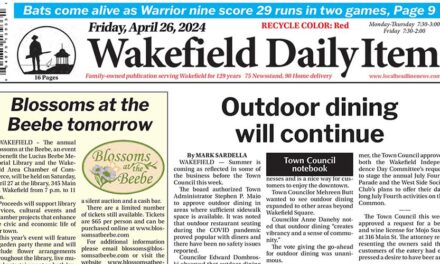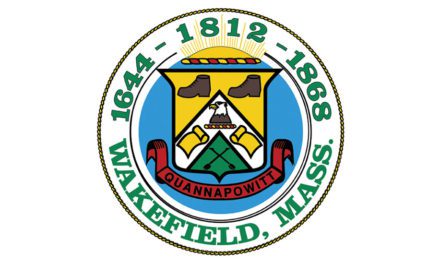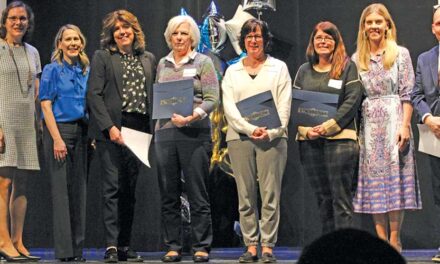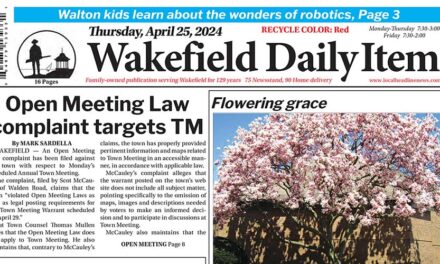Published in the April 1, 2019 edition.
By MARK SARDELLA
WAKEFIELD – Well over 100 residents came out last Thursday night for a forum on the future of Wakefield Memorial High School. The session was held at The Savings Bank Theatre at the high school.
The condition of the school building has been a concern for years, and for the last three years the town has sought acceptance into the Massachusetts School Building Authority’s (MSBA) program that provides state funding assistance with new construction or renovation projects.
While those previous Statements of Interest (SOI) have not succeeded in getting WMHS into the program, schools’ Superintendent Douglas Lyons expressed optimism on Thursday that a new and revised SOI, due to be submitted by April 12, will fare better. Last year, the school made it into the second round but did not survive the final cut.
Lyons began on Thursday by reviewing the existing conditions at the high school. He said that the building’s deficiencies had reached the point where they are “impacting academics.”
He pointed to science labs that are undersized by today’s standards and lack adequate chemical storage and ventilation.
Music and other performing arts are significantly limited by space constraints, Lyons said, and art and photography classes are also an area of concern. He said that taken as a whole, the school would seem to have adequate space but not all of that space is available for academics. He pointed to what he called “micro-overcrowding” by class and subject.
Lyons noted that the current high school was designed and built as a junior high school. Up to 25 high school students now occupy classrooms that were designed for 20 middle school children.
He noted that the handicapped accessible elevators are limited in number and are undersized.
While expressing optimism for this year’s SOI submission, Lyons acknowledged that the MSBA program is highly competitive and there are many other schools in the Commonwealth that also have dire needs.
WMHS Principal Amy McLeod said that last year the New England Association of Schools and Colleges (NEASC), which accredits high schools, moved Wakefield from “warning” to “probation” status, based on the deficiencies of the building.
She pointed to roof leaks and the building’s aging HVAC system, poor accessibility and outdated science labs. She said that teaching and learning were being impacted by a building that is not flexible and does not meet the needs of the 21st century. She said that emphasis should be on “better space, not more space.”
Lyons stressed that WMHS teachers were “doing an amazing job” despite the limits of the building.
Joseph Bertrand, chairman of the Permanent Building Committee, which would oversee any new high school construction project, talked about the requirements and procedures once a project is accepted into the MSBA program. The steps include conducting a feasibility study, hiring an owner’s project manager and securing the town’s share of the funding through Town Meeting and most likely a Proposition 2½ override or debt exclusion ballot question.
The next speaker at Thursday’s forum was Don Walter, principal of the architectural firm Dore and Whittier, which conducted the existing conditions study of the High School. Walter described the 2016, 2017 and 2018 SOI submissions and the analyses that his firm did that formed the basis of those submissions.
He talked about three options that were considered for addressing the needs at the high school. “Capital improvement” would address things like accessibility and other major issues but would not right-size classrooms and would cost about $78.4 million. A phased renovation would cost $136.4 million, he said, while new construction would cost between $132.5 million and $136.5 million. The MSBA would reimburse the town for about 50 percent of eligible costs.
Walter also talked about several options for a new high school, which involved building on the adjacent Walsh Field while students continue to attend classes in the current building. From acceptance by the MSBA to occupancy, the whole process would take six to seven years, he said.
Town Councilor Ann Santos said that the high school had not changed since her days as a student. She also spoke about the importance of community support for a project when seeking MSBA funding.
State Senator Jason Lewis stressed that the MSBA process is extremely competitive. He noted that last year only 12 projects were accepted out of 131 SOIs submitted. He offered assurances that the legislative delegation would support the town in any way possible.
Town Councilor Tony Longo echoed Santos’ comments, noting that nothing had changed since he graduated from WMHS in 1983.
Town Council Chairman Peter May said that a new high school is a top priority for the Town Council. He said that the Council will be voting to endorse the new SOI at its April 8 meeting.
Water Street resident Bob McLaughlin talked about the MSBA’s “Models School Program,” which seeks to effectively adapt and re-use the design of successful, recently constructed schools. By using existing successful plans, the program is designed to shorten and streamline the design process, reduce design fees, compress project schedules and accelerate construction start times, thus reducing overall project cost.
McLaughlin also questioned the need to even consider a renovation when a new building is what is needed. Walter answered that the MSBA wants to be assured that all possible solutions have been explored and exhausted.
Dolbeare parent Barbara LaSpina of Montrose School Lane asked what people could do in terms of support for a new high school.
School Committee Chairman Thomas Markham talked about the advocacy that had sprung up to support the Galvin Middle School project. He said that the movement was organic and grassroots with volunteers spending a lot of time on the campaign.
Christopher Kroon of Main Street asked how the new SOI would be different from the previous submissions.
Lyons said that more examples are provided showing how the state of the building is impacting teaching and learning. He also said that professional help was brought in to tighten up the SOI.
“I think we have made a compelling case,” Lyons said.
A Woodville parent asked if WMHS was in danger of losing its accreditation. Lyons assured her that the school would remain accredited.
Mike Scola, one of the founders of the “Galvinize Wakefield” movement that successfully advocated for a new middle school, observed that things were much further along in terms of public support for a new high school than they were at this stage for the Galvin.




